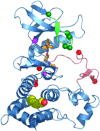The 2011 Gordon Wilson Lecture: overcoming resistance to targeted cancer drugs
- PMID: 23303979
- PMCID: PMC3540597
The 2011 Gordon Wilson Lecture: overcoming resistance to targeted cancer drugs
Abstract
During the past decade, molecularly targeted drugs have had a transformative impact on the treatment of several cancer types. Although the clinical benefits of these drugs are impressive, their effects are generally short-lived due to the acquisition of resistance. Unlike most cytotoxic agents, for which resistance mechanisms have remained obscure despite decades of clinical use, an understanding of the molecular basis of resistance to most targeted agents has emerged quickly. This rapid progress has been possible due to advances in molecular technologies that allow genome-wide profiling of patient samples. One important and consistent theme is that resistance is almost invariably associated with restoration of the signaling pathway inhibited by the targeted agent. Here I review examples from three diseases--chronic myeloid leukemia, prostate cancer, and lung cancer--that illustrate these points and reveal how insights into resistance mechanisms can rapidly accelerate the development of second-generation targeted therapies or combination regimens to improve patient outcome.
Conflict of interest statement
Potential Conflicts of Interest: The author is a co-inventor of MDV 3100 and may be entitled to royalty payments.
Figures



References
-
- Druker BJ, Guilhot F, O'Brien SG, et al. Five-year follow-up of patients receiving imatinib for chronic myeloid leukemia. N Engl J Med. 2006;355:2408–17. - PubMed
-
- Gorre ME, Mohammed M, Ellwood K, et al. Clinical resistance to STI-571 cancer therapy caused by BCR-ABL gene mutation or amplification. Science. 2001;293:876–80. - PubMed
-
- Shah NP, Nicoll JM, Nagar B, et al. Multiple BCR-ABL kinase domain mutations confer polyclonal resistance to the tyrosine kinase inhibitor imatinib (STI571) in chronic phase and blast crisis chronic myeloid leukemia. Cancer Cell. 2002;2:117–25. - PubMed
-
- Shah NP, Tran C, Lee FY, Chen P, Norris D, Sawyers CL. Overriding imatinib resistance with a novel ABL kinase inhibitor. Science. 2004;305:399–401. - PubMed
Publication types
MeSH terms
Substances
Grants and funding
LinkOut - more resources
Full Text Sources
Other Literature Sources
Miscellaneous
